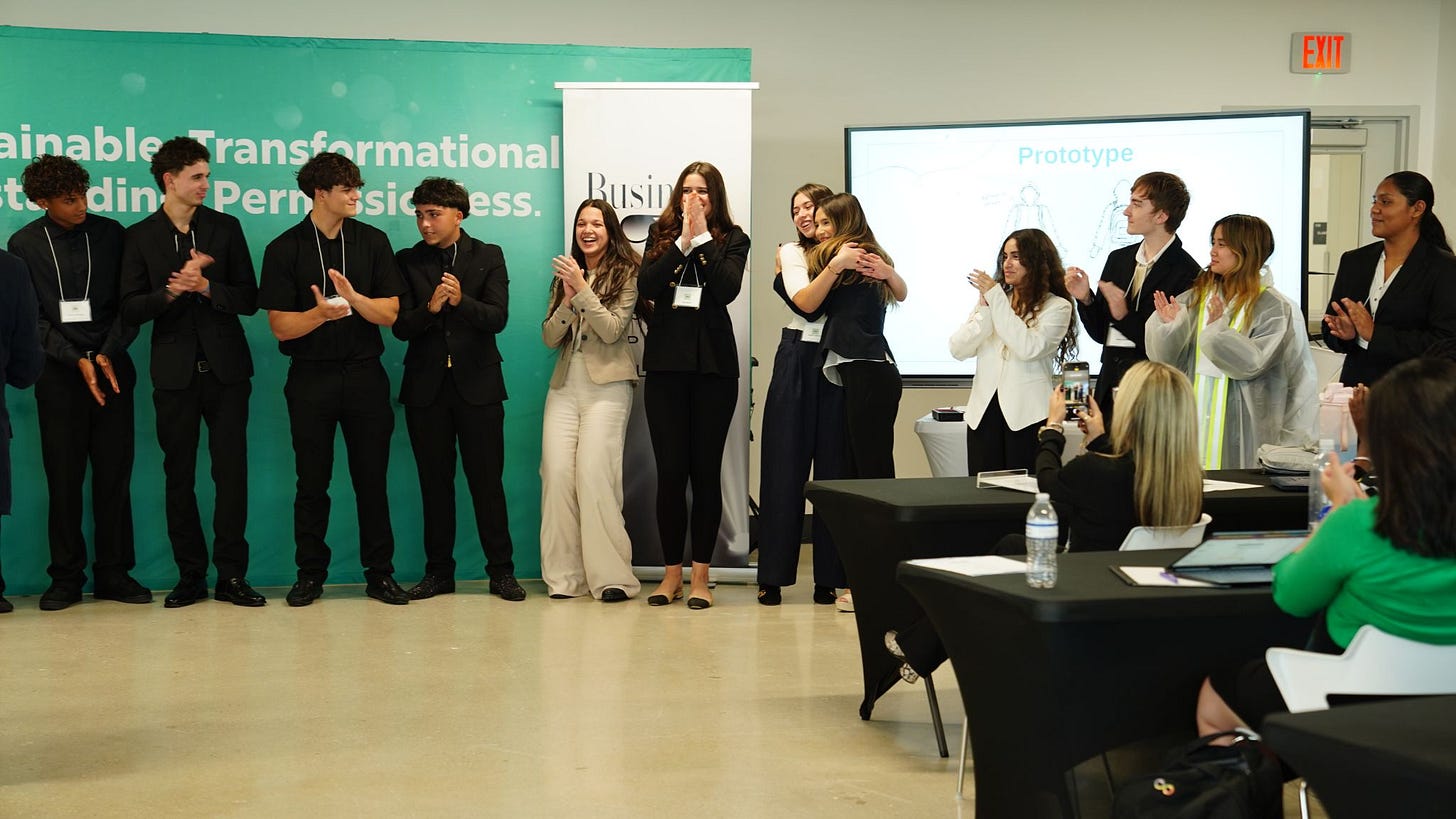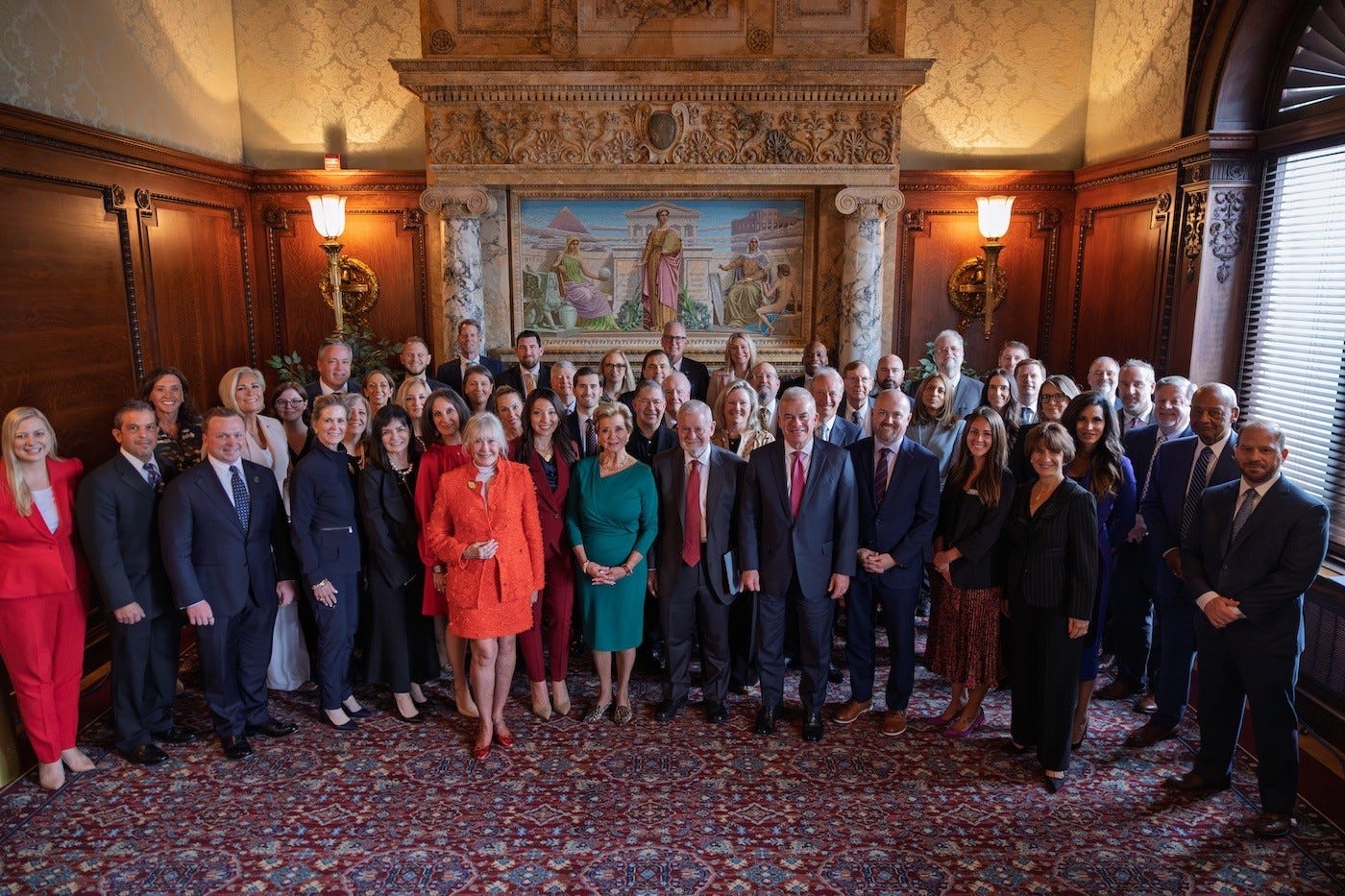Seize The Day
Parents, schools, and communities rising to shape the future of education.
The End of the School District as We Know It
At #RISE last week, I said something that startled a few people: districts are done.
Not education. Not schools. Not even public schools. But the district—the centralized bureaucracy that dictates what schools can and can’t do, that exists mainly to capture funds and shield itself from parents—is becoming irrelevant in places where families have real choice.
See, you have to understand. When you’ve spent as much time as I have going to schools that are untethered from a district, like the one in the lead picture - Miami’s Mater Brickell Academy by Academica - you understand what matters in student advancement, and what does not.
Districts were originally created to manage logistics and ensure equity. Over time, they turned into top-heavy organizations that put parents last and special interests first. They micromanage teachers, block innovation, and insulate themselves from accountability. That model cannot and should not survive in an era where funding follows the child.
Florida proves the point. Like the charter school market before it, in a market with education savings accounts available to every student, parents are customizing their children’s learning like never before. And what’s happening to districts? They’re scrambling to adapt. Just a year ago, only one district contracted with Step Up for Students to serve ESA families. Today, nearly 30 do—and more are applying. Why? Because families want access to AP classes, robotics labs, CTE courses, and other “extras.” Districts that open their doors find a new revenue stream. Districts that resist are left behind.
Public education doesn’t die when families choose differently. It thrives when schools adapt. Districts that reinvent themselves as service providers—offering transportation, HR, finance, or administration—may still have a role. But they will be one option among many, not the gatekeeper. Families and schools will decide whether to buy their services, just as charters and Catholic schools already do.
The lesson is simple: when parents are empowered, everyone must adapt. Those who innovate will flourish. Those who cling to the old monopoly model will fade into history.
See related piece below: “The Florida Effect: How Choice Changes Behavior” — an on-the-ground look at what happens when parents direct their dollars and districts learn to compete.
Parents Were Never Fringe — They Were Always First
At the same panel on this era we are in of parent voice, the exceptional moderator — and rare media talent — Greg Toppo asked us to respond to someone’s remark that parent-driven education is no longer fringe but rather “the fringe is becoming the cloth.” I had to chuckle. Parents were never fringe in the first place — they’ve always been ahead, pressing for change long before policymakers or pundits caught up.
Back in 1994, Time magazine ran a cover story on parents daring to create their own schools, painting them as outsiders. I remember taking calls from parents who said their neighbors thought they were crazy for questioning the local district. What they didn’t realize was that thousands of families across the country were hearing the same thing. That so-called “fringe” was actually the vanguard. Parents knew long before policymakers or pundits — and long before Covid — that something wasn’t working.
Every time the system has reached a breaking point, parents have been ready. During Goals 2000. During Race to the Top. Most dramatically, during COVID. They didn’t wait for the experts—they acted. They built schools, demanded new laws, pushed governors to move. In Iowa, Governor Kim Reynolds took a state with virtually no choice and turned it into one of the boldest universal ESA states in the country. Parents were already there, waiting for someone to open the door.
So let’s stop pretending parent power is fringe (though unions would have you believe otherwise). Parents have been ahead of us the whole time. The real challenge now is ensuring full and fair funding follows every child. A $7,500 scholarship or ESA is a start, but not when the traditional system next door spends $18,000 per student. Real empowerment requires equity in funding, not crumbs from the table.
The future of education isn’t about defending outdated systems. It’s about listening to parents—especially those with the fewest resources—who already know when their children aren’t learning and are determined to find a better way. The more freedom and funding we give them, the more innovative, pluralistic, and responsive education becomes.
Parents aren’t fringe. They’re the center of gravity. The rest of us are just catching up.
The Florida Effect
Some talk about the Mississippi Miracle, the laudable progress that once-sleeper state made in catapulting reading achievement from near bottom, to almost the top. The Florida Effect is what I call the other phenomenon making headlines: when parents are given real options in education, something remarkable happens: schools change.
Florida offers the clearest example. Thanks to its universal ESA law and strong choice policies, families are free to use their education dollars on what matters most for their children — whether that’s a robotics class, AP history, or a microschool tailored to their needs. With funding following students, public schools that once resisted choice are now adapting, competing, and even innovating to win families back.
The results speak volumes. Just a year ago, only one district was contracting with Step Up for Students to serve scholarship families. Today, 27 districts are on board and 10 more are applying. Superintendents across the state, from Miami-Dade to Lafayette, are welcoming scholarship students into their “cool stuff” — robotics labs, performing arts, CTE courses, dual enrollment.
Why the shift? Because when parents have power, districts must respond. Complaints give way to creativity, resistance to receptivity. Leaders are realizing that public education doesn’t die when families choose differently — it thrives when schools adapt. In fact, some districts are now exploring microschools of their own because they see families flocking to them.
It’s not just about Florida. This is what happens when choice and competition are real: families customize, schools diversify, and the old zero-sum “us vs. them” mentality dissolves. Parents are no longer passive consumers of a single system. They are active partners, assembling the education that works best for their children.
That’s why Florida ranks #1 on CER’s Parent Power Index. Other states take note: when you unleash parents with choice and ESAs, you don’t weaken public schools — you make them stronger, more responsive, and more relevant than ever.
Read all about it on the Step up for Students blog and kudos to Keith Jacobs and the team there for continuing to shed light on how choice works for all schools and students.
Standing Tall for America 250
Last week, I promised to share more about the meetings I attended around America’s 250th birthday — and I’m thrilled to report back.
The new coalition to promote education centered on civics in honor of the nation’s 250th was an inspiring gathering of more than 40 organizations (brilliantly organized by the America First Policy Institute) all committed to ensuring every student learns the essentials of our founding — and, just as importantly, develops a love of country that comes from understanding why we stand on the shoulders of giants.
The coalition’s mission? In the words of Education Secretary Linda McMahon: “Renew patriotism, strengthen civic knowledge, and advance a shared understanding of America’s founding principles.”
It was a remarkable day of collaboration, full of practical plans to equip students and teachers nationwide. As Hillsdale College President Larry Arnn reminded us, echoing his institution’s founding president: “Freedom and learning go together, and ignorance and slavery go together.”
As he urges us all: “Read the Declaration of Independence…one of the most consequential and beautiful documents of all history. Read it again and again. It proclaims the rights of us all.”
That’s why Hillsdale is partnering with the White House on the new Story of America video series. As the White House describes it:
“This history series tells the remarkable story of American independence. It highlights the characters and events that led a rag-tag army to defeat the mightiest empire in the world and establish the greatest republic ever to exist. This is the story of America. This is our shared heritage — and our proud destiny.”
Check it out.
Federal Policy Can Amplify Civics Learning...
…In more ways than one. More on this point in the future, like the upcoming grants for such efforts, but for now, I want to spotlight some timely thought leadership from Vicki Murray at the Washington Policy Center, who zeroed in on how the new ECCA can strengthen civics education across all types of schools.
She writes:
“What if there was a way to help all schools—public and private—strengthen civics education? This summer, Congress created exactly that opportunity by enacting the country’s first-ever federal tax-credit scholarship program.
“This groundbreaking program makes virtually all K-12 students eligible for scholarships covering educational expenses—but only if Governor Ferguson opts Washington state in. Here’s how it works: taxpayers receive dollar-for-dollar credits worth up to $1,700 against their federal income taxes for scholarship donations. These scholarships could fund civics curricula and supplies, as well as tutoring, transportation, special education services, after-school programs, private school tuition, and more.
“It’s a real win-win scenario. Parents gain access to educational resources that best serve their children’s needs, while generous federal tax credits help make our state more affordable—at no additional cost to Washington taxpayers.”
Her words get to the heart of the opportunity. Federal policy has opened a door — and if states choose to walk through it, civics learning could expand in ways we’ve never seen before. Imagine every school, public and private, with the resources to bring history alive through better curricula, programs, and supports for students.
Some may think we talk too much about Florida, or choice, or civics. But the old saying applies: “Those who don’t know history are doomed to repeat it.” If we don’t teach history well, we risk repeating its failures — and missing its lessons of freedom and resilience.
The path is clear. With federal tools like this tax-credit scholarship program, and state leaders bold enough to seize them, we can help ensure that every student learns not just the story of America, but why it still matters.
We are in the middle of a movement. From civics to choice, from federal innovation to grassroots parent power, history isn’t just something to be studied — it’s something to be made.
So let’s seize the day. And as always, have a great week. - Jeanne




